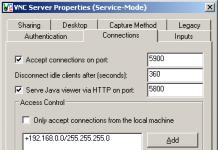How to change screen resolution
12/15/2013 windows | for beginners
This may also be of interest to you:
The question of changing the resolution in Windows 7 or 8, as well as doing it in the game, although it belongs to the category “for very beginners,” is asked quite often. In this instruction we will touch not only directly on the actions required to change the screen resolution, but also on some other things.
In particular, I will tell you why the required resolution may not be in the list of available ones, for example, with a Full HD 1920 by 1080 screen it is not possible to set the resolution higher...
0 0
As you know, screen resolution plays an important role when installing and using the Windows 8 operating system and the updated version 8.1. If the resolution does not meet the minimum requirements (1024x768), then many applications that come with this operating system simply will not work. This can happen when you try to install Windows 8 on netbooks, where some models have a non-standard screen resolution of 1024x600. Today we will look at a method to bypass these limitations using the HP Mini 110 netbook as an example.
Why exactly are we talking about netbooks? The whole point is, and this is no secret, the performance of the Windows 8 operating system is much higher than its predecessors, for example, Windows XP, Windows 7, and Windows Vista is not even a question. In addition, when testing the new system on outdated equipment, it showed excellent results, outperforming Windows XP installed on the same equipment by approximately 30%. Netbooks have...
0 0
Hello, friends! Today we will figure out how to change the screen resolution in Windows.
This is done simply. On an empty space on the desktop, right-click and select “Screen Resolution”
The “Screen Settings” window opens. In the “Resolution” field, open the drop-down list and select the recommended one (in my laptop it is 1366 x 768)
The recommended resolution of a monitor or laptop screen can be found in the specification for the device (Usually the recommended resolution is written on the product box. If there is no box, you can look it up on the equipment manufacturer’s website by searching by model. The model of the laptop or monitor is usually written on the device case).
Resolution is the number of pixels displayed horizontally and vertically on your screen. The resolution directly determines how much useful information you will see on the screen and what size this information will be (about size, see the second paragraph of this article - how to enlarge the image).
0 0
Changing the screen resolution plays an important role in Windows 8. A higher resolution allows you to see more tiles on the Start screen, but a lower resolution will allow you to see text better. Connecting an external monitor or TV means you'll want to adjust the resolution as well as which screen has which desktop.
You can get to the Screen Resolution window from your desktop.
If on the Start screen, click Windows Key. Otherwise, skip this step Press Windows Key + D to clear the desktop Right click on an empty space and click change resolution
Right-click anywhere on your desktop and select Change Resolution.
You can also get there from the control panel. Once in the Control Panel, under Appearance and Personlization, select Adjust Screen Resolution.
Adjust the Screen Resolution section is what you...
0 0
The procedure for changing screen resolution is familiar to most Windows users, but some of the nuances of this operation remain unknown even to experienced users. Therefore, let's once again answer in detail the question of how to change the screen resolution - even if you know how to do it, you will find something new for yourself.
Windows 7
Windows 7 users have probably already learned the system inside and out, but sometimes they may have difficulty performing simple actions. So, to change the resolution:
Right-click on the desktop and go to the “Screen Resolution” section. In the “Resolution” line, set the desired value. Save the changes by clicking the "Ok" button.
It's simple, but some users have problems displaying text and icons after performing this procedure. To avoid such moments, follow the recommendations below:
Set the resolution that is marked as recommended. Specify the specific meaning...
0 0
Types of monitors
The resolution of your monitor or laptop screen determines the clarity of text or images shown on the display. With a high resolution, for example, 1900x1200 pixels, all objects will look sharper. Also, objects become smaller, and accordingly more of them will fit on the screen. And at a low resolution, for example, 1024x768 pixels, the size of images and text increases, only their clarity becomes worse.
The available resolution to use depends on the monitor itself. Thus, older CRT monitors usually have a diagonal of 17 inches and only support a resolution of 800x600 or 1024x768 pixels.
LCD monitors or laptop screens have a diagonal of 17 and above, and also support higher resolutions. And the larger the monitor itself, the higher the resolution it can support. The ability to increase screen resolution depends on the diagonal of the monitor, as well as on the video adapter used.
How to change...
0 0
A lot of users of the new operating system from Microsoft complain that they can’t figure out how to change the screen resolution, because the feature has disappeared from “Personalization”:
Some people somehow begin to get used to the incorrect screen resolution, others begin to demolish Windows and return to the old 7/8.1, and we will try to explain how this can still be done on Windows 10, and even in several different ways. We want to say right away that there is no point in getting used to the wrong resolution. You should use the capabilities of your laptop or computer for as long as it is designed for, so if a problem arises, it must be addressed immediately.
You will not be able to change the screen resolution from “Personalization” 100 percent. In order to do this without leaving “Settings”, you need to click on the gear and you will be taken to the updated “Control Panel”:
It has only 9 submenus so far, but with updates it will...
0 0
WikiHow works like a wiki, which means that many of our articles are written by multiple authors. This article was created by volunteer authors to edit and improve it.
Windows 8, despite all the flak it has received to foist a tile-based Modern UI on users, is actually a very good update to Windows 7 - faster, simpler and offering a good set of new features. But there's a catch: you need a display resolution of at least 1024x768 to install it. This isn't an issue for most people, but a significant portion of them own netbooks, most of which come with 1024x600 screen resolution displays such as the Asus Eee PC 1005HA.
If you try to run Windows 8 or 8.1 Setup from inside Windows XP or Windows 7, you will be notified that your resolution is not high enough and you will not be able to continue. It's a shame because Windows 8 is a perfect match for the low-power Atom processor in most netbooks.
With this guide, you can upgrade your old netbook to version 8 or 8.1!
Steps
-
All is ready! The downside is that due to the low resolution, you won't be able to run any modern Modern UI apps, but you don't really need them. Everything else works just fine! Check out the Tips section below to enhance your netbook experience.
- If you used gadgets on Windows 7, you can purchase the free "8gadgetpack" to get them back.
- Modern Start Screen isn't used much on non-touch devices, much less a netbook, because you won't be running any modern Modern UI apps. You'll want to have the good old Start menu back, so look for and install "Classic Shell 4.0" (or higher). It mimics the Start menu and even lets you turn off that abrupt transition from Desktop to Modern. It even lets you boot into Windows right on your desktop! Classic Shell is a free application.
- Make sure your RAM is expandable. 2GB is the maximum that most netbooks can go up to, and that's good.
- This is a little high-level advice, but you'll thank yourself for following it. Your netbook probably came with a regular hard drive (HDD). If you remove it and place a solid state drive (SSD), Windows 8 performance will be overwhelmed. We're talking 30 second boot cases and a summary of 13 seconds of inactivity!
Warnings
- Make a backup. There are quite advanced steps in this guide that may render the netbook unusable and/or cause you to lose some or all of your data. Use a free tool like AOMEI Backupper, or simply copy all the files to a portable hard drive before you begin.
What you will need
- Installed Windows 7 OS: If you're running Windows XP, it's fairly easy to upgrade to Windows 7, so you might want to do that before following the tutorial.
- ISO file for Windows 8 or 8.1. Check that the Windows 8 installation you are using is 32-bit (x86) and not 64-bit (x64), as most netbooks have a 32-bit processor. The same goes for video adapter drivers.
- At least 10 GB of free space. You can delete your old Windows 7 folder later to free up space.
Extract the Windows 8.1 ISO file to a folder on your root drive. C:\Win81Setup is a great location. Your netbook will restart several times during the installation process, so it's not a good idea to run the installer from a removable drive.
Use a registry hack to enable higher permissions. This Windows 7 step allows you to increase the resolution beyond the maximum 1024x600. While in Windows 7, open Registry Editor. Find all examples with the key "Display1_DownScalingSupported" and double-click on them to change the value of each one to "1".
Reboot your computer for the registry hack to take effect.
Change to a higher resolution. Right-click on your desktop and select "Screen resolution". Now you can change the resolution to 1024x768 or even 1152x864. Select any of them and click Apply.
Start installing Windows 8.1. Go to the Windows 8.1 installation directory and run the installer. You should be able to follow the installation steps without a hitch. There will probably be 3-4 reboots before everything is done. Once Windows 8.1 is installed and running, you will find that your resolution is set to 800x600. The registry hack mentioned above no longer works on Windows 8.1. The good news is that you can select a higher value, but the bad news is that you cannot select higher for the maximum.
Download graphics adapter drivers. Go to Intel's website and download the appropriate Mobile Intel 945 driver for Windows 7 32-bit. You'll need to confirm what graphics adapter your netbook is running with, but either way, the Windows 7 version should do the trick.
Install the driver. This may probably change the resolution to 1024x600 instantly, or it may require a reboot, so restart.
Screen resolution is a customizable virtual parameter on each personal computer that determines the output quality of the transmitted image. Typically, this parameter automatically is selected according to the size and format of the monitor, taking into account its characteristics. But each user can change it to suit their own characteristics and needs.
For what influences monitor format:
- On playable content, as well as the ability to play it.
- For image quality and clarity.
- The number of objects that will be displayed on the screen.
- The size of the black margins on the edge of the output image.
In addition, it depends on the type of monitor itself amount of points per inch. Thus, CRT displays maintain low picture quality, while new types of screens made using LCD technology maintain higher picture quality.
For example, on old computer and laptops recommended set the monitor resolution to no more than 1280x800 dpi, as this is the optimal indicator for the displayed image on unproductive hardware. As you probably already understood, the quality of the picture depends performance PC. That is why this parameter can be changed by each user.
How to change resolution in Windows XP, 7, 8
Change quality to Windows XP:
Change quality to Windows 7 and 8 occurs according to a similar scheme, only the visual design of the context menu items differs:

Change resolution in Windows 10
IN Windows 10 The logic of using the operating system has been almost completely redesigned. In the new version of the OS, you can change the screen format in two ways.
Using the settings

Via control panel

What to do if the resolution does not change
If the screen resolution does not change in the standard way (via the desktop), then the user should try to enter the item parameter changes via the control panel. Also, the inability to perform the operation may be due to the fact that the monitor do not support selected format.
Screen resolution determines the clarity of text and images displayed on the screen. At higher resolutions, such as 1920x1080 pixels (Full HD), objects appear sharper. In addition, objects appear smaller, and more of them can fit on the screen. At lower resolutions, such as 1024x768 pixels, fewer objects fit on the screen, but they appear larger.
Typically, the larger the monitor, the higher resolution it supports. The ability to increase screen resolution depends on the size and capabilities of the monitor, as well as the type of video adapter used.
There are several ways to change the screen resolution:
1 Using standard Windows tools.
2 Using third-party utilities (usually when installing drivers on a video card, you already install a program in which you can change image settings).
Change screen resolution using standard Windows tools.
In order to change the screen resolution in Windows7/Windows 8.1, you need to right-click on the desktop and select " Screen resolution".
In line " Permission"Using the slider you can select the required screen resolution.

After selecting the resolution, you must press the " Apply", a window will appear prompting you to save the settings if you do not press within 15 seconds "Save changes", resolution settings are not saved. This is done to be able to automatically return the settings to the previous ones, so if you select the wrong screen resolution, click the Apply button and everything disappears/distorts the image, then after waiting 15 seconds everything will come back and you will understand that the selected resolution is not suitable for your monitor .

In addition, you can change the frequency of the picture changing on the screen, to do this, click " Extra options", go to the tab " Monitor" and in the Monitor settings field select Screen refresh rate.

Change screen resolution with third-party programs.
Often, when installing drivers on a video card, in addition to the driver, a program is installed that helps adjust the image on the monitor. In particular, if you have an Nvidia video card, then you probably have the Nvidia Control Panel. In order to launch this panel, you need to right-click on the desktop and select " NVIDIA Control Panel"or launch it from the taskbar (the icon will be near the clock).

Windows itself selects the optimal screen resolution based on: monitor (display) size, video adapter, installed drivers. The article will tell you how to change the screen resolution in Windows 10, 7, 8 if you notice any deviation in the display (blurriness, mismatch in size, the appearance of black bars on the sides).
Screen resolution is measured in horizontal and vertical pixels. With low resolutions of LCD monitors (displays), for example, 800 by 600, fewer objects will fit on the screen and they will appear larger. At higher resolutions, such as 1920 by 1080, objects will appear smaller, thereby allowing you to see more elements displayed. Modern monitors (displays) allow you to set a resolution lower than the native one without loss of quality. To set up the most acceptable picture, follow the recommendations below.
Manually changing screen resolution
To change the screen resolution on Windows 7, 8, right-click on a free space on the desktop. In the menu that pops up, select “screen resolution” to open display settings (they helped in the previous article).
There is another way to get to the resolution change settings. . In the “view” area, set small or large icons. From the list of options, find “screen”, click it.

Note: if all screens are not displayed, click “find”, if you are not sure which display needs to change the resolution, click “determine”. This will briefly show a large screen sequence number to uniquely identify it.
In the screen settings you click on which a vertical slider will become available. To decrease or increase screen resolution in Windows, drag the slider. The native resolution is marked as “recommended” and is the highest, which is optimal.

Click OK, then you will see a preview of the selected resolution and a message if you are sure click “save change”.
You can change the screen resolution in Windows 7, 8 from the list of ready-made options. In the screen settings, click “advanced options”. Next, on the “adapter” tab, click “list of all modes”. Modes consist of 3 elements: resolution, color depth, refresh rate (in Hz). Select a mode, press OK, OK, confirm changes.

In Windows 10, screen resolution changes slightly differently. When you call up the menu, by right-clicking (on an empty space on the desktop), you need to select “screen settings”.


Click on the current resolution, then set yours. Don’t forget, the optimal one is the one next to which there is a “recommended” mark. Click "Apply" and then "Save Changes". This way, you can change the screen resolution in Windows 10. If you encounter problems, read on.

I present a program for changing screen resolution - Carroll. It also allows you to set each account its own permission. Download the zip archive and unzip it. Install Carroll on your computer.
After launching the program, many resolution options (other parameters) will be available in its interface; select the optimal one. To change the screen resolution on Windows and save it every time you start your PC, click on the first link and “yes” in the message.

Enabling Screen Settings
Sometimes when you try to adjust the screen resolution on Windows 10, 7, 8, the options become pale and cannot be changed. There are 2 ways to enable these settings.
1. Download the archive with the reg file and unpack it. Run vkl-razresh.reg, when the User Account Control prompt appears, click “yes”, then “yes”, OK. Restart your computer to apply the changes.
2. Open Group Policy Editor. To call it, enter gpedit.msc, click OK. In the editor, go to the “screen properties window” section (see screenshot). On the right side, double-click on the screen settings option. In the next window that opens, mark one of the two states: “not set”, “disabled”. Next, click OK and close the windows. At the same time, you can change the screen resolution without restarting the computer.

Troubleshooting problems when changing resolution
Users are faced with the problem that the screen resolution in Windows does not change or changes, but before the first reboot or exit. It is recommended to restart the system first; if the problem persists, try these tips:
- Recently installed programs may well have a negative impact on the resolution settings in Windows. You will need .
- Make sure there are no problems with your graphics drivers. Check whether the drivers are installed at all, and also make sure that the latest versions are installed.
- , see if it helps or not.
- Press Win + R, type msconfig, press enter. In System Configuration Options, go to the "boot" tab. Make sure the "base video" option is unchecked. If you unchecked the box, click OK and restart your PC.

As you can see, changing the screen resolution in Windows 10, 7, 8 is quite simple, especially in most situations it’s not worth it, because by default the OS itself selects the optimal settings. By following the recommendations, you can easily identify and eliminate any problems with the display of the monitor (display).


























